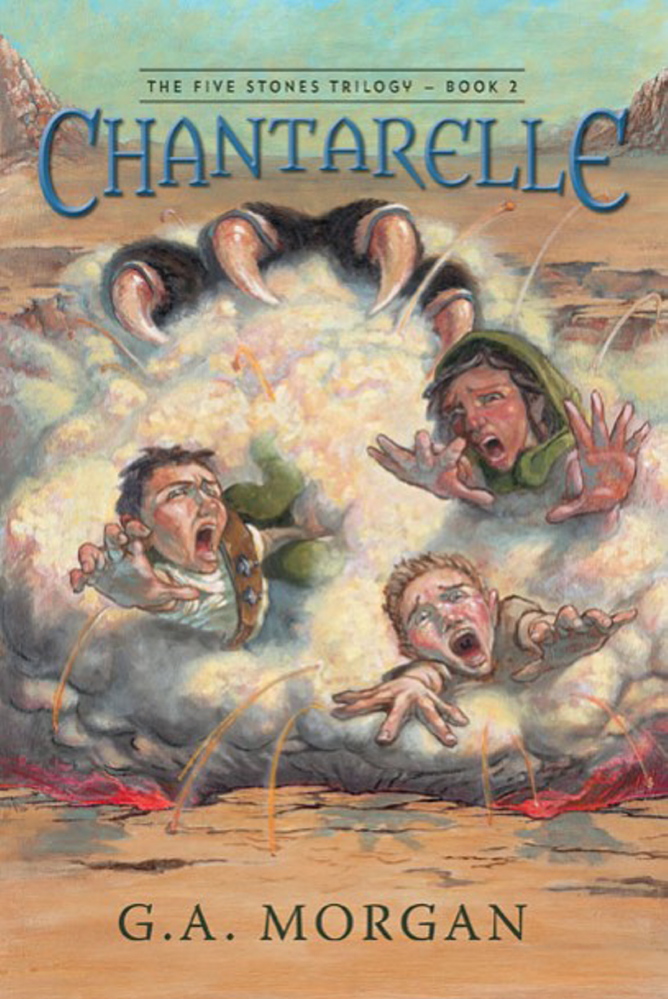The second book in the young adult trilogy “The Five Stones” follows a group of three children and one sea captain to a magical land called Ayda. But we don’t need to squint too hard to recognize the foggy island setting as Maine’s familiar coastline.
Writer G.A. Morgan, grew up in New York City and spent her childhood summers on an island off the Maine coast, and she looked to that beloved landscape to set “Chantarelle.”
After releasing last year’s “The Fog of Forgetting,” the first in the adventure-fantasy trilogy, Morgan explained how the idea came to her.
“I began the ‘Five Stones’ trilogy as a way to distract (my children) when they were very young on a long, long hike up a cold, rainy mountain,” she said in a video on her website. “I started a story about three brothers and two sisters who steal a boat one day on a sunny afternoon. But suddenly the fog rolls in and they find themselves somewhere completely unexpected, in very dangerous territory, and have to battle their way back home.”
It is precisely this familiar formula of children discovering a magical world in plain sight that lends the book its magic.
“Chantarelle,” named for the elfin man who leads the children from their homes in Maine through an underground tunnel to Ayda, is best when the rules for each interaction are clear and emotionally resonant. It occasionally misses the mark when the logic and ethics are intuitive rather than clearly expressed. Characters often use their “daylights,” for example, their inner compass and energy, to understand what to do, yet this prevents the child protagonists from making decisions based on morality and articulating their desires and thoughts. It’s instead chalked up to “daylights” rather than human reason or agency.
The novel hits its stride when two of the “outliers” (those who reach Ayda from the world we know), meet Bodi, a member of the most dangerous tribe in Ayda, and discover she is not so different from them after all. It is Bodi who helps disguise the protagonists so they can enter battle safely, where they meet their brother and friend.
This convergence of time and place – seeing the unexpected within the familiar, being both an Aydan and from the real world – lends an element of surprise, as characters are revealed throughout the novel to be people from back home, who also happen to be hundreds of years old. It is a welcome reminder that within childhood, endless possibilities for magic and bravery exist in worlds shared only between children.
Ayda is not so different from Narnia, nor are the caves on the coast different from the magical wardrobe. Magic and fantasy, according to this author, are where you look for them.
Morgan leaves us mid-action, but we know the trilogy will conclude with “The Kinfolk” in July 2016. The siblings are far enough along on their journey to express great maturity. Towards the end of the book, one brother comes to the realization “that everything truly important happened between two people because somebody somewhere gave up something that mattered, even when they didn’t really want to.”
This applies to life in Ayda as well as life back home, and it seems likely that courage, love for one another and daylights will carry these children through the adventures of one more book.
Ellen O’Connell is a freelance writer who lives in Portsmouth, New Hampshire. She can be contacted at:
ekoconnell@gmail.com
Send questions/comments to the editors.



Success. Please wait for the page to reload. If the page does not reload within 5 seconds, please refresh the page.
Enter your email and password to access comments.
Hi, to comment on stories you must . This profile is in addition to your subscription and website login.
Already have a commenting profile? .
Invalid username/password.
Please check your email to confirm and complete your registration.
Only subscribers are eligible to post comments. Please subscribe or login first for digital access. Here’s why.
Use the form below to reset your password. When you've submitted your account email, we will send an email with a reset code.